#electrical learning in philadelphia
Text
Exploring The Fundamental Aspects Covered In HVAC Classes
Discover the foundational principles of HVAC systems through HVAC classes. Explore the six essential components for mastering HVAC fundamentals.
#HVAC training schools in Philadelphia#HVAC trade programs in philadelphia#HVAC classes in Philadelphia#electrician certification in philadelphia#electrician program in philadelphia#manufacturing training in philadelphia#electrician school in philadelphia#electrical learning in philadelphia#electrician classes in philadelphia#manufacturing programs in philadelphia
0 notes
Text
The State Birds Initiative:
New Jersey (#3)

Welcome to the third official poll of the State Birds Initiative! Before the poll, though, one thing real quick. My suggestion is that you read the post below before voting in the poll below. That's especially important if you're lacking any context about the birds being presented as the new (or old) State Bird of the Garden State, New Jersey. This is to be fully informed as to why these are being presented, and to make your choices appropriately. Lastly, some of these birds, you will notice, may go against some of the rules listed in the introduction post. All is explained after the jump where the explanations are, I promise you that. But with that...OK! Here's the poll! If you'd like to see the last post, check out Pennsylvania (Poll | Results)
So, with that done...New Jersey.
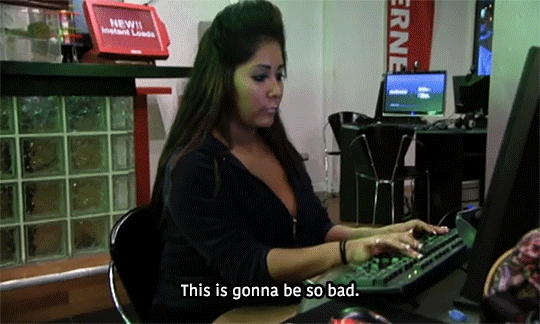
OK, I'll be honest, I have very little history with New Jersey. Only been there a few times, I've driven through it a decent number of times, and I mostly know it by reputation. But, uh...for whatever reason, every trip I take that requires me to go through New Jersey, NJ is the worst driving portion of that trip. Basically every time. Maybe that's a New Jersey turnpike problem, maybe that's unhappy coincidence. Hell, maybe it's conservation bias from being a New Yorker (upstate, but I've gone to the city regularly throughout my life). Or maybe it really is cultural reputation for New Jersey trickling in to my subconscious (looking at you, Jersey Shore). But either way...I have complicated feelings about New Jersey.
But this post is NOT about my personal geographic experience. Mostly. It's about birds! So, let's get into New Jersey objectively. Third state admitted into the union, state capital is Trenton, largest city is Newark, and it's the most densely populated state in the country. Famous for being the origin of electricity in civic infrastructure, as well as the home of their favorite son, Thomas Alva Edison. Which...when you learn more about the guy, makes you wonder about New Jersey as a whole. MOVING ON! It was a major staging point in the American Revolutionary War, and ever since, it's been all about freedom. Even though you can't pump your own gas there. Although, to their credit, the Statue of Liberty is actually technically in New Jersey waters. Yeah. That's absolutely true. But, like...it's spiritually a New York landmark, so we'll let it slide.

Now, here's the thing about New Jersey, seriously and truly. It has a bad reputation because of media and New York City. This is for two more specific reasons, from what I can tell. One, the New Jersey Turnpike sucks, and it smells like raw sewage due to its proximity to industrial factories and processing plants. And unfortunate way to experience the state, and the main way I've experienced New Jersey personally. So, that's one, and it's not indicative of the state's quality. Number two is simply the fact that it's a hub for commuters, with lots of people going to either NYC or Philadelphia for work. Because of that, Jersey itself gets pieces of their cultures combined, which also makes it a very easy target with a unique accent. So, not Jersey's fault.
In reality, it's quite a nice state with more natural area than you'd expect for somewhere so densely populated. New Jerseyans, unsurprisingly love their state...and aren't big fans of tourists, from discourse I see online. It's a small state, which makes it crowded enough. Plus, there are tourist attractions there. There's the massive American Dream Meadowlands mall, there's MetLife Stadium, there's Six Flags Great Adventure, there's...Trenton. Actually, no, Trenton sucks, I stand by that assessment. But it's also a highly diverse state, with the highest proportion of Hinduism followers in the country, as well as the densest collection of LGBTQ+ social centers (AKA gayborhoods), amongst other things. NJ does deserve more credit.
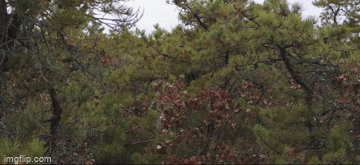
Now with that said, let's talk about the natural world of New Jersey, because there is a surprising amount to talk about. 45% of the land is covered in mixed deciduous-coniferous forest, which you've probably noticed is typical of the NE USA. Oak is our primary tree here, which is also probably why Northern Red Oak (Quercus rubra) is the state tree. It also has some major ecological features that are well known for its natural advantages. Cape May is a seaside city and vacation resort, but also one of the most well-known and important sites for birders from the United States during migration seasons, making it immediately prominent for this post. Great Swamp NWR in the north is the first wilderness area ever designated by Congress, and also serves as a major refuge for birds during the breeding season for various reasons. And maybe most importantly, the New Jersey Pine Barrens are the largest remaining pine barrens in the NE USA, and act as a bastion of diversity. More on this later, I promise; there's a species entry dedicated to this unique environment.
And that's not all to talk about here. NJ's environment needs some focus for a number of reasons, not least of which being that the state has more toxic waste dump sites than any other state in the Union, which are the focus of the federal Superfund environmental remediation program. Yeah, there's some cleanup that needs to happen in the state, especially as it is so small. Of 150 federally listed sites, only 35 have been cleaned up since the 1970s. So, yeah. We should get on that, please. But with that said, NJ has relatively low carbon dioxide emissions compared to other states, they're seventh in solar power, and get most of their electricity from natural gas and nuclear power. So, it's a greenish state that could be a lot greener.
There's a lot to talk about for such a small state, it would seem. Let's not linger about, and let's get on with the show here! I'm honestly kind of excited. Birds after the jump!!!
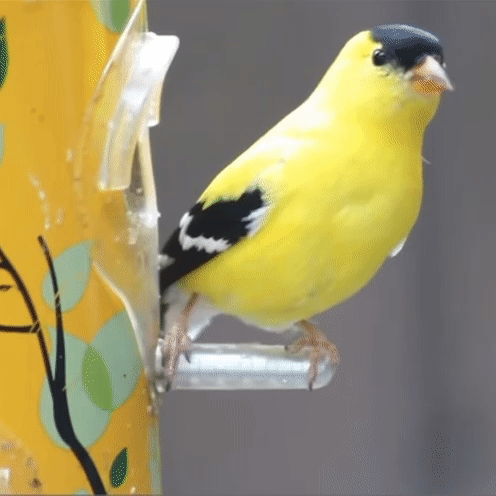
American Goldfinch (Spinus tristis)
Let's kick things off by talking about the incumbent, the American Goldfinch (Spinus tristis). Now, why was the American Goldfinch chosen as the State Bird of New Jersey in 1935? Easy answer: favoritism. The bird was nominated as the only candidate by the New Jersey Audubon Society because...it was their mascot at the time. Yeah. That's it. In reality, the New Jersey State Bird is the New Jersey Audubon Society. And even then, it's officially lost its relevancy, because that's not their mascot anymore. More on that later.
What's actually worse about the goldfinch here is...for some reason, not a lot of New Jerseyans have actually seen them. Part of the reason for this entire series, by the way is this Reddit post, which stoked the fires that had long been simmering deep within my soul. OK, not that deep, but still. Anyway, the header of that post is that the OP had barely ever seen an American Goldfinch, despite being a native. I thought that was insane (and said as much in my comments), because this is a ridiculously common bird, especially for birdwatchers. But, uh...I've looked into since then. And only 0.4% of its global breeding population resides in the state. What's crazy is, this is a common sentiment amongst New Jerseyans. They just...haven't seen this bird. And obviously, that/s not every new Jerseyan, and a lot have reported seeing it. But to be honest...is this bird really worth being called the State Bird of New Jersey?
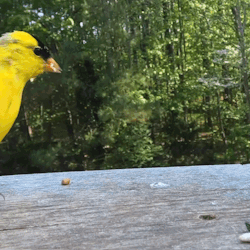
OK, can we make the American Goldfinch make sense in retrospect? Let's see, they're a highly social finch species throughout the year, living in dense colonies in the spring and summer especially. The males are late breeders with ornate flying displays meant to attract females, and may group territories with other males to defend against predators. And they're an open secondary growth forest specialist that live in the state year-round, including during the breeding season. Which means...well, actually, it means that they're perfectly suited to live in New Jersey, funnily enough.
Hear me out here. There are two things that goldfinches love most: forest clearings and weeds. New Jersey may be 45% covered in forest, but it does have deforestation as a minor problem around its settlements. However, that's not a problem for the goldfinch, who thrives in secondary growth forests that occur as a result of succession. Given an attempt in recent decades to recover New Jersey's forests, this means the goldfinch is a potential symbol of these efforts. Plus, its love of the seeds that come from flowers that are pest plants, like dandelion, thistle, ragweed, and cosmos, make it a potentially attractive bird for gardeners of the state to attract, especially as those plants thrive in open fields during stages of succession!
...YES I'M STRETCHING MORE THAN AN AUSTRALIAN BREAKDANCER WITH A DOCTORATE TRYING TO MAKE A POINT, BUT WHAT ELSE AM I SUPPOSED TO DO WITH THIS MASCOT OF AN ORGANIZATION NAMED AFTER A SLAVE-OWNER???
So...moving on.
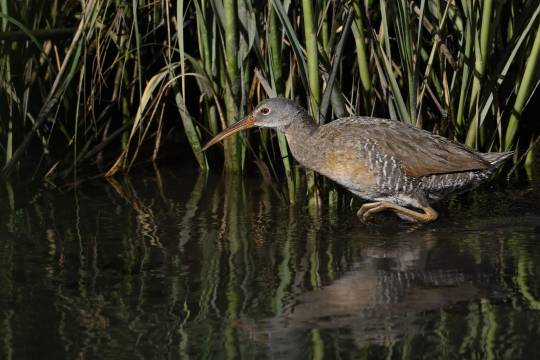
Clapper Rail (Rallus crepitans)
While the majority of natural New Jersey is covered in forest, it still has a fairly important habitat in the form of the saltmarsh. Just to get the definition in place early, a saltmarsh is essentially what it sounds like: a vegetation-dominated coastal biome with salt and brackish water, salt-tolerant grasses and plants, and the animals that depend on such. They're coastline preservers, trapping and binding sediment as it makes its way to and from the ocean, and acting as a major supply for the food web along the coasts. They're incredibly important habitats, and this will not be (and have not been) the last time you've seen them during the State Birds Initiative.
Now, obviously, these habitats are chockful of birds. New Jersey has a few major salt flats along its coast, all of which shelter some major breeding populations of birds. One of these species is the Clapper Rail (Rallus crepitans), which is our eBird-sponsored pick of this poll. Clapper Rails have 13% of their global population in New Jersey saltmarshes, meaning they're quite dependent on this unique habitat, and most of their population breeds in the state. Some people may never have seen or heard of a rail, but in case you're one of those people, just know that they're a smaller semi-aquatic relative of cranes. If you've seen a coot, moorhen, or gallinule, then you've seen a rail! And the Clapper Rail is a crustacean-eating, saltmarsh-loving, new Jersey-dependent example. And that said...it is kinda boring looking to the average person.

Don't take me wrong! For me, this bird is fantastic, and would actually be a lifer for me, personally. But the average non-birder? Look, in instances like this, I usually tap into the part of my brain my fiancee lives in rent-free, and all I can hear is her shouting "LONG DUCK LONG DUCK" over and over. I love these guys, but I'm not sure they'd resonate with the public. Plus, as far as saltmarshes go, these are good representatives, but I'm not sure they're the best. Are these a good New Jersey representative? Possibly, since they represent a major ecosystem in the state, and that is important. But I'll leave that question to you all. Moving on!

Cape May Warbler (Setophaga tigrina)
OK, onto the category of birds that are named after the state, and New Jersey has one of those! The Cape May Warbler (Setophaga tigrina) is so-named because the first specimen described by Alexander Wilson was collected in Cape May, New Jersey by George Ord. That said, it's certainly a unique warbler, easily recognizable, and dependent upon conifer forests dominated by spruce, which the Pine Barrens are...not. Still, an iconic bird in New Jersey! Except...wait, hold on...ah. It doesn't breed in the state. In fact, after it was described from a Cape May specimen, it wasn't seen in the area again for...a century. So...yeah, it's named after a major location in the state, known for birds at that, and yet it's barely found there?Love this bird, but...maybe think about renaming it one of these days.

Pine Warbler (Setophaga pinus)
Now, the Pine Warbler (Setophaga pinus), on the other hand, that's a better warbler representative of New Jersey. Well, sort of. To be fair, the Pine Warbler only has 1% of its global breeding population in New Jersey, so the state isn't a bastion or reservoir for the species. However, there is a major reservoir of the species in the New Jersey Pine Barrens, which I'd mentioned earlier. And hey, Pine Barrens, Pine Warbler...slam dunk for representation of the habitat right there. And yeah, that's absolutely relevant to the species as a whole. They live, eat, and breed in pine-dominated forests, exactly like (and including) the Pine Barrens. It's actually listed as a "Significant Congregation" species by the New Jersey Audubon Society.
And as for making a good State Bird of New Jersey? It's a notable bird, even keeping the goldfinch's yellow with white wing bars. It's not terribly difficult to find, especially during the breeding season in areas like the Pine Barrens. And hey, they're even well-known to live with other species, making them an important biodiversity indicator for conservation purposes. Plus, if people go out to look for the Pine Warbler in the wild, they'll likely encounter other species like the Blackburnian Warbler (Setophaga fusca) or the Tennessee Warbler (Leiothlypis peregrina), amongst others. Fostering interest in birdwatching by chance! It works in a conservation sense...but I don't know that it's particularly emblematic of New Jersey, to be fair.
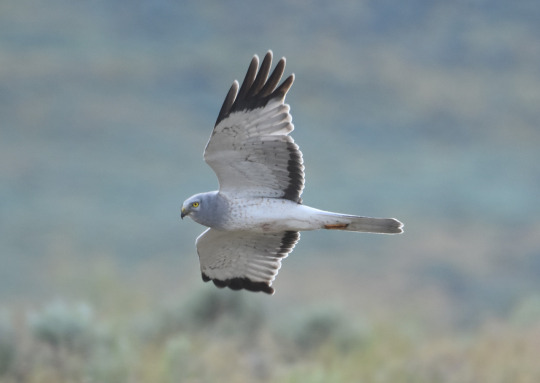
Northern Harrier (Circus hudsonicus)
Now, here's an interesting choice! If the current State Bird, the American Goldfinch, was chosen because it was the mascot for the New Jersey Audubon Society at the time, then by that logic, their current mascot should actually be the State Bird of New Jersey. And so, in that case, may I present to you the current mascot of the NJ Audubon Scoiety, and the next candidate for State Bird...the...is that a Northern Harrier (Circus hudsonicus)? Yeah, looks like it, and some sources I have confirm that's the case. But, uh...why?
Let me be really clear about something first off: I adore the Northern Harrier. Also caleld the marsh hawk, they're a beautiful raptor native to brackish and salt mashes, as well as grasslands and fields, hunting small mammals, insects, and the occasional bird. They're one of the few accipiters that are silent fliers, ambushing prey from above like owls. They even have the disc-like face. They're one of the new North American raptors with sexual dimorphism (the smoky gray male is pictured above, as compared to the brown females), and their iconic coloration has given them the nickname of the Gray Ghost. WHICH IS BADASS. They're also one of the only polygynous raptors, meaning a male can mate with several females in a given season, nesting on the ground and hatching chicks. Because of their unique relationships, some indigenous peoples see them as a symbol of healthy marriage. Finally, these are considered good for agriculture, as they eat rodents and not chicken. I love harriers, they're super neat birds, and it's always a pleasure to see them in the wild. Also, they DROWN THEIR PREY!!! What the hell! That's terrifying!
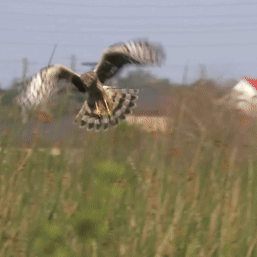
OK, harriers are cool, but do they have a relevance to New Jersey outside of being the logo of New jersey Audubon? Well...they do breed there...barely. But they've been observed doing so, so that counts. They represent key habitats in the state of New Jersey, so that's great. Their certainly charismatic enough (GRAY GHOST), and they've got nationwide conservation concern as an endangered species. So, it has those qualities going for it as the State Bird candidate. We'll see what the poll says. In the meantime, let's move on!

Laughing Gull (Leucophaeus atricilla)
Y'know, my original plan was to put the Ring-billed Gull (Larus delawarensis) in this list as well...and then, I stumbled upon a fun fact. The black-headed cousin of the Ring-billed Gull, and Laughing Gull, is a regular traveler to New Jersey, and in fact has a colony right off of the Jersey Shore, making them a fairly well-known and recognizable resident of an iconic area of the state. But pretty importantly, the species has a pretty massive breeding population in New Jersey. 5% of the breeding population of the species are in southern NJ, which isn’t the bulwark of their breeding population in the USA (that'd be Louisiana, according the eBird Status and Trends), but it's still a significant portion.
That said, the Laughing Gull is a recognizable member of the New Jersey shore community, and I mean the term "community" in multiple contexts. Ecologically, they're omnivorous scavengers that are well-adapted to living in a densely populated state, as well as in saltmarshes and other coastal environments throughout New Jersey. Sociologically, they hang around human settlements so much that they see opportunities in human hands...literally. The Laughing Gulls of the Jersey Shore are pretty notorious for stealing food out of the hands of beachgoers and boardwalk visitors. There are even boardwalk restaurants with signs saying they won't offer refunds if your food is stolen by a gull. They're SO notorious, in fact, that falconers have been hired to use their falcons to drive away these birds. And honestly...that's a shame. After all, the Laughing Gulls are such prominent citizens that humans have had to adjust to them.
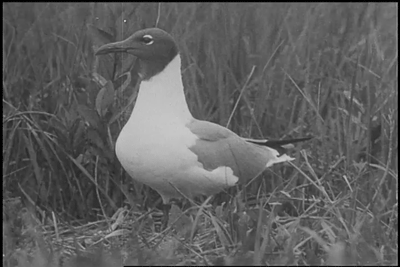
But that said...I'm gonna quote Brian Donahue, the reporter at the end of the video/new report I linked to above...because it's hilarious, and it makes an interesting statement that I think people from New Jersey should think about. Read the quote, but trust that I have a somewhat well-thought out idea supporting it.
Derided as "flying rats" by many, I think it's time to reconsider the Laughing Gull, because if things haters say about Laughing Gulls (they're loud, feisty, there's too many of them...
(Interviewee Kathy McCarey): They're rude...they're very demanding...and they come for what they want...I don't like 'em.)
...are the same things haters often say about New Jerseyans. Laughing Gulls are us. They deserve more respect.
youtube
Look, as extremely funny as that point is...there's a point about that statement. That is something that people say about New Jerseyans! They live in a state full of garbage, they're obnoxious and loud, all of that kinds thing. And New Jerseyans love their state as much as anybody else; SO MUCH, in fact, that many people online say they actually love that stereotype, because it means that people STAY OUT OF THEIR STATE. Funny or not, true or not...there's a point there. Laughing Gulls, as with all gulls, have a bad reputation, which is mostly undeserved. They're opportunists trying to feed themselves and their young, who see a smorgasbord of food right in front of them, in their neighborhood! In their place, what would YOU do? Honestly, these guys are a solid contender for that reason alone.
Plus, honestly...it's kinda funny.
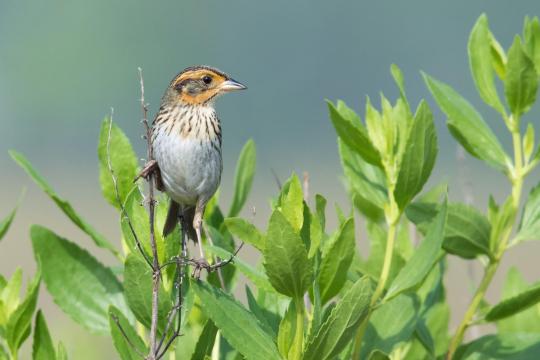
Saltmarsh Sparrow (Ammospiza caudacuta)
Finally, let's look at the conservation focus for this post: the Saltmarsh Sparrow (Ammospiza caudacuta). So, this is a pretty big one, especially when looking at New Jersey. A full 32% of the species' global population breeds in this state, which is, frankly, a MASSIVE proportion of any species. What's more, they're considered an endangered species, which immediately makes this an impressive contender for the State Bird of New Jersey. And as one of the most endangered species in the Eastern USA, not to mention a species of immense scientific interest for ecological and genomic reasons, this bird should get some attention by the public and federal government.
However...and this is a point to be made here...it's not exactly the most iconic bird for non-birders. As a birder who would kill to get this on his lifelist (I AM WORKING ON IT, LITERALLY TOMORROW AS I AM TYPING THIS), this is a prominent bird within certain communities. And to others? Ugh, this is gonna hurt me to say, you have no idea, but...it's a sparrow. It may be a little harder for people to become attached to a sparrow, and even more difficult for people to recognize the Saltmarsh Sparrow specifically.
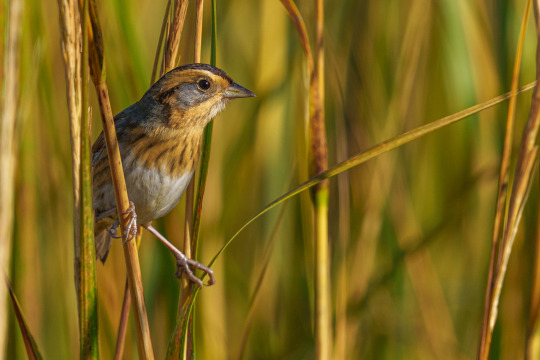
Don't believe that this matters? Do me a favor, bird people. Show your non-bird friends Bird A, Bird B, and Bird C. Ask them how many different species you showed them. I'm willing to bet the especially observant will say 2. The less observant are gonna say 1. And throw in these top two pictures, while you're at it. I'm willing to bet you'll still get a 2 or 3. Because, unfortunately, to many people, sparrows all look pretty similar. And going forward, that's something we'll have to keep in mind: a unique appearance. What makes a bird iconic is also in its uniqueness and identifiability. And sure, maybe I'm not giving the average person enough credit, but we're also talking about children. I've said it before and I'll say it many times over: kids are important targets to consider when choosing natural State Symbols. And I really don't know how many adults could tell the difference between some sparrows, even professionals. And, uh...the Saltmarsh Sparrow is a very important example of this, because it wasn't even a species until the '90s.
Oh, and kudos to those of you who caught on immediately to my little trick up there. Probably a good amount of you noticed it, but if you didn't...there are five species of sparrows shown in this post. The two birds pictured in the post? Different species. Yeah, hearing that now makes that more obvious, but you may not have noticed it immediately. The first bird pictured is indeed the Saltmarsh Sparrow. The second bird, however, is the Nelson's Sparrow (Ammospiza nelsoni), which was once considered the same species as the Saltmarsh Sparrow. Dirty question, I know, but it's also found in New Jersey. Not a breeder there, but it's enough to cause a bit of confusion. See what I mean?
Oh, as for the rest, Bird A is LeConte's Sparrow (Ammospiza leconteii), Bird B is a Savannah Sparrow (Passerculus sandwichensis), and Bird C is a Grasshopper Sparrow (Ammodramus savannarum).

Please understand, bird-peeps: I hate making this argument. Genuinely. The New World sparrows are a wonderful group, and a really fun one to play around with and hunt down as a birder. And don't worry, sparrows will be getting a mention in my personal list. But as for the State Bird? I'll let you all decide.
And with that, that's the end of this post! I miss any big ones? Make any leaps a bit too big? Feel free to let me know! In the meantime, stay tuned for State #4 - Georgia! Wait...wait, the fourth state to be admitted into the Union was Georgia? Huh. Go figure.
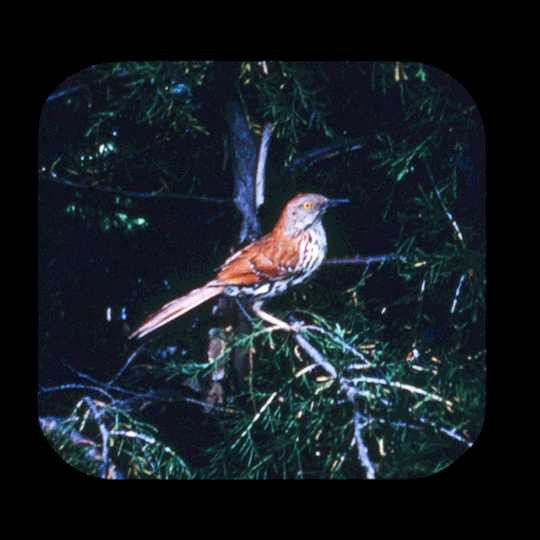
See you next time, and happy birding!
#birds#bird#state bird initiative#state birds initiative#birdwatching#bird watching#birding#birders#black birder#state bird#new jersey#birdblr#birblr#american goldfinch#eastern goldfinch#spinus tristis#saltmarsh sparrow#sparrow#golfdinch#ammospiza#laughing gull#gull#seagull#northern harrier#raptor#clapper rail#rail#rallus#cape may warbler#cape may
135 notes
·
View notes
Note
4, 7, 42 !!!
4. what are you looking forward to?
Going back to school so I can enjoy my first full year as a high school library assistant and do all the fun things I have planned for the year (I started last December so I only got a half year).
I'm also planning on going to a few shows in September. I'm excited to finally get to see Magdalena Bay (a synth-pop duo I've loved for a while now) and I'm catching Electric Light Orchestra one more time in Philadelphia before Jeff Lynne hangs it up. I'm sure there are other things I'm excited for, but that's all that's coming to mind currently.
7. what was your life like last year?
I had just finished earning my master's degree in English Lit, I finally left retail for good (although it would be months before I would start my current job), and was enjoying the summertime. My father was still alive and little did I know that he would be gone in three months. Still strange to think about sometimes. But I was happy then and I'm still relatively happy now! Just some things are different now :)
42. favourite book(s)
Oh jeez! This is a hard one. I don't know if I have a definitive favorite, but I can name a bunch of ones I really love!
The book I've probably re-read the most is The Great Gatsby and it's my go-to example of a breezy story that's just easy to go back to and just holds up well. Very few people can be called "The Voice of Their Generation," but I think F. Scott Fitzgerald really captured the world around him and his specific moment in a way that few others could. I think The Beautiful and Damned also does that really well.
I've always loved J.D. Salinger's Franny and Zooey (to the point where I wrote my undergraduate thesis about it). The way he writes character dialogue is simply unmatched. Most of that book is conversation, but it never feels like it's dragging. You feel like a fly-on-the-wall listening in on two characters talking about heavy stuff that maybe you shouldn't be hearing, but you can't resist. I know Catcher in the Rye has a reputation and stink surrounding around it, but Holden Caufield is such a fully realized character by the end of the second page and his narrative voice just jumps off the page. Salinger's characters have always felt like real people to me and it makes for incredible reading.
Two recent favorites of mine have been Reaper Man and Soul Music by Terry Pratchett, two of the many books in his Discworld series. I love them for different reasons. Reaper Man explores why Death himself feels its important to give a shit about the humans he's tasked with taking to the afterlife ("What can the harvest hope for if not for the care of the reaper man?") Soul Music is just a great demonstration of Pratchett's humor, his ability to weave pop culture and music references seamlessly into his fantasy, and present a fun and heartfelt story that explores what happens when his characters are introduced to something from our world (rock n' roll in Soul Music's case). Terry's "Death" series of Discworld books kept me laughing and kept me going when my dad passed (don't ask me what attracted me to the "Death" series during that time hahaha).
Different Seasons by Stephen King has always been one of my favorites (it got me back into reading in tenth grade). I fell in love with "The Shawshank Redemption", really enjoyed "The Body" (which became the movie Stand By Me) and loved the realistic horror of "The Breathing Method." I'm currently knee-deep in his Dark Tower series, but that's one of my favorite King works because the horror is understated and not supernatural based. He uses the four novellas in that work to explore realistic characters and real horrors (prison, how easy it is to fall into fascism, learning about your own mortality, and the fear that comes with difficult pregnancies and the unknown-ness of whether a mother will survive the delivery). I love it! I revisit it every couple years.
I could shoot your ear off about books forever, but I promise I won't do that! :)
Anyhoo! Thanks for submitting some questions! This was fun!
From this post. Feel free to submit a number, if you so choose!
5 notes
·
View notes
Text

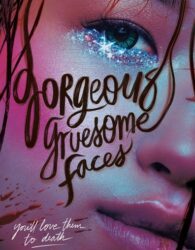



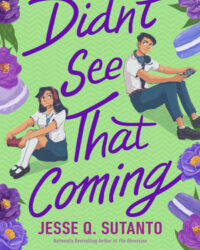
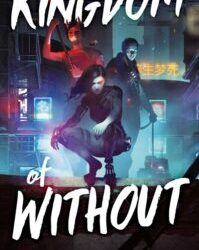
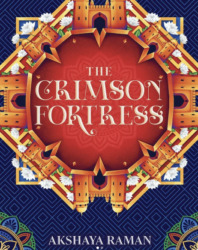
New Releases for November 2023
We have eight titles on our November release list. There's quite a mix with a few contemporaries, some romance, a fantasy, a super hero story, and a thriller to look forward to this month. Here's a peek.
With or Without You by Eric Smith
Inkyard Press
All’s fair in love and (food truck) war.
Everyone knows Jordan Plazas and Cindy Ortiz hate each other.
According to many viral videos of their public shouting matches, the Plazas and Ortiz families have a well-known food truck rivalry. Jordan and Cindy have spent all of high school making cheesesteaks and slinging insults at each other across their shared Philadelphia street.
But the truth? They’re in love, and it’s all just an act for the tourists.
When the fake feud lands them a reality tv show pilot, Jordan and Cindy find themselves having to lie on a much bigger scale. Trapped between pursuing their dreams or their love, can they find a way to have their cheesesteak and eat it too?
Gorgeous Gruesome Faces (Gorgeous Gruesome Faces #1) by Linda Cheng
Roaring Brook Press
After a shocking scandal that abruptly ended her teen popstar career, eighteen-year-old Sunny Lee spends her days longing for her former life and cyberstalking her ex-BFF and groupmate, Candie. The two were once inseparable, but that was then—before the tragedy and heartache they left in their wake.
In the here and now, Sunny is surprised to discover that Candie is attending a new K-pop workshop in her hometown. Candie might be there chasing stardom, but Sunny can’t resist the chance to join her and finally confront their traumatic history. Because she still can’t figure out what happened that horrible night when Mina, the third in their tight-knit trio, jumped to her death. Or if the dark and otherworldly secrets she and Candie were keeping had something to do with it . . .
But the workshop doesn’t bring the answers Sunny had hoped for, nor a happy reunion with Candie. Instead, Sunny finds herself haunted by ghostly visions while strange injuries start happening to her competitors—followed by even stranger mutilations to their bodies. In her race to survive, Sunny will have to expose just who is behind the carnage—and if Candie is out for blood once more—in Linda Cheng’s spellbinding sapphic thriller that will have readers screaming and swooning for more.
Static Up All Night by Lamar Giles & illustrated by Paris Alleyne
DC Comics
VIRGIL (aka STATIC) can do amazing things with his vast array of electrical abilities, but instantly mending a broken heart isn’t in his skill set.
Virgil Hawkins has just gone through a bad break up. He can’t get over his ex, so his best friend Richie has an idea for how to distract attend a music festival in their city of Dakota. But wouldn’t you know it—his ex is in attendance. And that’s just the beginning of his troubles.
A series of encounters and events leads to an all-night adventure involving super villains, a diner, a reluctant rapper, and a size-changing kleptomaniac, as well as Virgil’s frequent bad decision making. But in the end, with the help of his friends, Virgil will find he can move on from a broken heart.
Wish of the Wicked (Wish of the Wicked #1) by Danielle Paige
Bloomsbury YA
For centuries, the enchanted members of the Entente have worked in tandem with the Three Fates—the Present, the Past, and the Future—to maintain destiny across the Thirteen Queendoms. But when Queen Magrit learns of her untimely demise from Hecate, Fate of the Future, Magrit burns Hecate at the stake and decrees death to all Entente in order to live forever.
But some survive, including sixteen-year-old Farrow, who hatches a dangerous plan to seek revenge. Along the way, she finds herself falling for the one person who could ruin everything. With life and love hanging in the balance, she must decide who to trust and what’s most important: living in the past or forging a new future.
Bestselling author Danielle Paige launches a brand-new fairy godmother origin story full of intrigue, magic, and romance.
Artifacts of an Ex by Jennifer Chen
Wednesday Books
When Chloe Chang gets dumped via USPS after moving across the county from NYC to LA, her first instinct is to throw her box of memories in the garbage. Instead, she starts buying other teenagers’ break-up boxes to create an art exhibit, Heartifacts. Opening night is going great, until she spots Daniel Kwak illicitly filming his best friend’s reaction to his ex’s box. When she tries to stop him, an intense discussion ends up launching a creative partnership and friendship… and a major crush for Chloe.
There’s just one problem: Daniel is dead set on not being another rebound.
Five times he’s been the guy who makes the girls he’s dating realize they want to get back with their ex. And he refuses for there to be a sixth. She insists she’s over her ex, but when he shows up unexpectedly with his new girlfriend, it turns out Daniel was right. She isn’t ready for a new relationship.
She throws herself into making Heartifacts successful, but flashy influencers threaten her original vision of the exhibit. To create the exhibit she’s always wanted, Chloe needs to go back to basics, learn to work with artists in a more collaborative way, and discover what love can be. Only then will she convince Daniel she’s truly ready for everything they could be to one another.
Didn’t See That Coming by Jesse Q. Sutanto
Delacorte Press
A hilariously fresh and romantic send-up to You’ve Got Mail about a gamer girl with a secret identity and the online bestie she’s never met IRL until she unwittingly transfers to his school, from the bestselling author of Dial A for Aunties, The Obsession, and Well, That Was Unexpected.
Seventeen-year-old Kiki Siregar is a fabulous gamer girl with confidence to boot. She can’t help but be totally herself… except when she’s online.
Her secret? She plays anonymously as a guy to avoid harassment from other male players. Even her online best friend—a cinnamon roll of a teen boy who plays under the username Sourdawg—doesn’t know her true identity. Which is fine, because Kiki doesn’t know his real name either, and it’s not like they’re ever going to cross paths IRL.
Until she transfers to an elite private school for her senior year and discovers that Sourdawg goes there, too.
But who is he? How will he react when he finds out Kiki’s secret? And what happens when Kiki realizes she’s falling for her online BFF?
Kingdom of Without by Andrea Tang
Simon & Schuster Books for Young Readers
When Zhong Ning’er takes the job, she expects a smash-and-grab burglary she’s doing to make rent and help out a friend. What she doesn’t expect: a sad-eyed army boy who dreams of insurrection, a former rebel leader trapped inside a secret lab, a group of aspiring revolutionaries who are first collaborators, then compatriots, and then, perhaps, friends.
But this is Beijing, nearly a hundred and fifty years after General Yuan Shikai successfully declared himself emperor in 1915. His descendants rule the country from their seat in the imperial city, their gendarmerie—the Beiyang Army—run the streets, aided by cyborgs and the Brocade Guard. Walls have risen, dividing the city into districts called Rings—nominally only by geography, but in truth by class. Earthquakes devastate the northern farmlands, crops drown in the southern typhoons, and all over the country people are hooked on a drug they call Complacency.
As a Sixth Ring girl who watched previous uprisings crushed brutally by the court, Ning’er isn’t much of an optimist, and she’s certainly no revolutionary. But that might not be up to her—as the stakes get higher, the time for passivity is quickly running out, and she must decide if she wants to sit idly in her cynicism, or embrace the breathless, terrible possibility of hope.
The Crimson Fortress (The Ivory Key Duology #2) by Akshaya Raman
Clarion Books
In this thrilling, action-packed sequel and conclusion to the critically acclaimed Ivory Key duology called “a dream”* (Booklist, starred review), royal siblings Vira, Ronak, Kaleb, and Riya battle vengeful enemies, centuries-old mysteries, and their own personal demons in order to save their country from ruin.
The search for the Ivory Key has brought royal siblings Vira, Ronak, Kaleb, and Riya closer than they have been in years as they try to restore magic and stability to Ashoka. But despite finally getting their hands on the long-lost key, uncovering its cipher has proved more complicated and dangerous than they ever expected.
Their missions force them to split up and disperse them across Ashoka and beyond. When a rash decision by the council strips Vira of her power, her journey to reclaim her throne takes on new meaning. Kaleb travels to the neighboring country of Lyria to uncover its emperor’s motives and meets a prince seeking answers of his own. Ronak’s efforts to escape his arranged marriage and exonerate his brother lead to a series of risky deals that only bring him closer to what he’s running from. And Riya’s newfound power has turned unpredictable, but her search for answers only raises more questions.
When their attempts at decoding the key release an ancient power, the siblings must align to face the past and save their future once and for all. In a quest that culminates in a deadly labyrinth, there’s only one way they will succeed: together.
17 notes
·
View notes
Text
Hanif Abdurraqib's essay is so carefuly woven. The whole series of Lost Notes on 1980 looks great. I have only listen to this post. It moved me.
My memory seems unrealible, sometimes I check things out. Last Tuesday I was searching for the reports of the announcement that Nelson Mandela would be released from prison in February of 1990 because I remember.
In 1990 I had graduated and got my teaching credentials. I was doing an internship at an environmental learning center in western Pennsylvania. And I had signed up for a big job fair across the state near Philadelphia. At the environmental center, the night before the job fair the environmental center was hosting Damian Randle who had founded Green Teacher Magazine. I was especially excided to meet him because of his connection with Centre For Alternative Technolgy near Machynlleth Wales.
I stayed for Randle's presentation and drove the night through to the job fair. In my gut I knew teaching wasn't for me, but it still took a while for that realization to dawn on me. So I suffered bleary-eyed through multiple interviews at the job fair. I didn't click with anybody there. Leaving the conference center and retriving my car I turned on the radio as I tried to get my bearings. The news was that Nelson Mandela would be released from prsion. I was a bit incredulous, but the news shot electricity through my body.
There are reasons to hope and the struggle continues.
Hanif Abdueeaqib
10 notes
·
View notes
Text
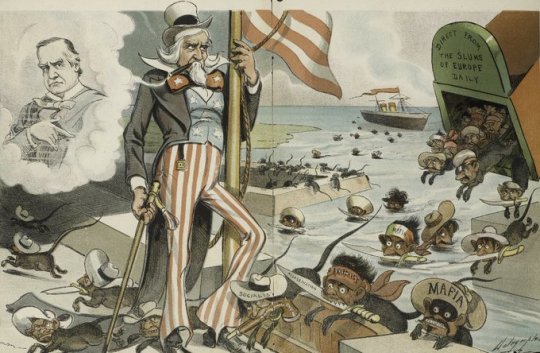
This political cartoon by Louis Dalrymple appeared in Judge magazine in 1903. It depicts European immigrants as rats. Nativism and anti-immigration have a long and sordid history in the United States.
* * * *
LETTERS FROM AN AMERICAN
March 28, 2024
HEATHER COX RICHARDSON
MAR 29, 2024
Yesterday the National Economic Council called a meeting of the Supply Chain Disruptions Task Force, which the Biden-Harris administration launched in 2021, to discuss the impact of the collapse of the Francis Scott Key Bridge and the partial closure of the Port of Baltimore on regional and national supply chains. The task force draws members from the White House and the departments of Transportation, Commerce, Agriculture, Defense, Labor, Health and Human Services, Energy, and Homeland Security. It is focused on coordinating efforts to divert ships to other ports and to minimize impacts to employers and workers, making sure, for example, that dock workers stay on payrolls.
Today, Transportation Secretary Pete Buttigieg convened a meeting of port, labor, and industry partners—ocean carriers, truckers, local business owners, unions, railroads, and so on—to mitigate disruption from the bridge collapse. Representatives came from 40 organizations including American Roll-on Roll-off Carrier; the Georgia Ports Authority; the International Longshoremen’s Association, the International Organization of Masters, Mates and Pilots; John Deere; Maersk; Mercedes-Benz North America Operations; Seabulk Tankers; Under Armour; and the World Shipping Council.
Today the U.S. Department of Transportation’s Federal Highway Administration announced it would make $60 million available immediately to be used as a down payment toward initial costs. Already, though, some Republicans are balking at the idea of using new federal money to rebuild the bridge, saying that lawmakers should simply take the money that has been appropriated for things like electric vehicles, or wait until insurance money comes in from the shipping companies.
In 2007, when a bridge across the Mississippi River in Minneapolis suddenly collapsed, Congress passed funding to rebuild it in days and then-president George W. Bush signed the measure into law within a week of the accident.
In the past days, we have learned that the six maintenance workers killed when the bridge collapsed were all immigrants, natives of Mexico, Honduras, Guatemala, and El Salvador. Around 39% of the workforce in the construction industry around Baltimore and Washington, D.C., about 130,000 people, are immigrants, Scott Dance and María Luisa Paúl reported in the Washington Post yesterday.
Some of the men were undocumented, and all of them were family men who sent money back to their home countries, as well. From Honduras, the nephew of one of the men killed told the Associated Press, “The kind of work he did is what people born in the U.S. won’t do. People like him travel there with a dream. They don’t want to break anything or take anything.”
In the Philadelphia Inquirer today, journalist Will Bunch castigated the right-wing lawmakers and pundits who have whipped up native-born Americans over immigration, calling immigrants sex traffickers and fentanyl dealers, and even “animals.” Bunch illustrated that the reality of what was happening on the Francis Scott Key Bridge when it collapsed creates an opportunity to reframe the immigration debate in the United States.
Last month, Catherine Rampell of the Washington Post noted that immigration is a key reason that the United States experienced greater economic growth than any other nation in the wake of the coronavirus pandemic. The surge of immigration that began in 2022 brought to the U.S. working-age people who, Director Phill Swagel of the nonpartisan Congressional Budget Office wrote, are expected to make the U.S. gross domestic product about $7 trillion larger over the ten years from 2023 to 2034 than it would have been otherwise. Those workers will account for about $1 trillion dollars in revenues.
Curiously, while Republican leaders today are working to outdo each other in their harsh opposition to immigration, it was actually the leaders of the original Republican Party who recognized the power of immigrants to build the country and articulated an economic justification for increased immigration during the nation’s first major anti-immigrant period.
The United States had always been a nation of immigrants, but in the 1840s the failure of the potato crop in Ireland sent at least half a million Irish immigrants to the United States. As they moved into urban ports on the East Coast, especially in Massachusetts and New York, native-born Americans turned against them as competitors for jobs.
The 1850s saw a similar anti-immigrant fury in the new state of California. After the discovery of gold there in 1848, native-born Americans—the so-called Forty Niners—moved to the West Coast. They had no intention of sharing the riches they expected to find. The Indigenous people who lived there had no right to the land under which gold lay, native-born men thought; nor did the Mexicans whose government had sold the land to the U.S. in 1848; nor did the Chileans, who came with mining skills that made them powerful competitors. Above all, native-born Americans resented the Chinese miners who came to work in order to send money home to a land devastated by the first Opium War.
Democrats and the new anti-immigrant American Party (more popularly known as the “Know Nothings” because members claimed to know nothing about the party) turned against the new immigrants, seeing them as competition that would drive down wages. In the 1850s, Know Nothing officials in Massachusetts persecuted Catholics and deported Irish immigrants they believed were paupers. In California the state legislature placed a monthly tax on Mexican and Chinese miners, made unemployment a crime, took from Chinese men the right to testify in court, and finally tried to stop Chinese immigration altogether by taxing shipmasters $50 for each Chinese immigrant they brought.
When the Republicans organized in the 1850s, they saw society differently than the Democrats and the Know Nothings. They argued that society was not made up of a struggle over a limited economic pie, but rather that hardworking individuals would create more than they could consume, thus producing capital that would make the economy grow. The more people a nation had, the stronger it would be.
In 1860 the new party took a stand against the new laws that discriminated against immigrants. Immigrants’ rights should not be “abridged or impaired,” the delegates to its convention declared, adding that they were “in favor of giving a full and efficient protection to the rights of all classes of citizens, whether native or naturalized, both at home and abroad.”
Republicans’ support for immigration only increased during the Civil War. In contrast to the southern enslavers, they wanted to fill the land with people who supported freedom. As one poorly educated man wrote to his senator, “Protect Emegration and that will protect the Territories to Freedom.”
Republicans also wanted to bring as many workers to the country as possible to increase economic development. The war created a huge demand for agricultural products to feed the troops. At the same time, a terrible drought in Europe meant there was money to be made exporting grain. But the war was draining men to the battlefields of Stones River and Gettysburg and to the growing U.S. Navy, leaving farmers with fewer and fewer hands to work the land.
By 1864, Republicans were so strongly in favor of immigration that Congress passed “an Act to Encourage Immigration.” The law permitted immigrants to borrow against future homesteads to fund their voyage to the U.S., appropriated money to provide for impoverished immigrants upon their arrival, and, to undercut Democrats’ accusations that they were simply trying to find men to throw into the grinding war, guaranteed that no immigrant could be drafted until he announced his intention of becoming a citizen.
Support for immigration has waxed and waned repeatedly since then, but as recently as 1989, Republican president Ronald Reagan said: “We lead the world because, unique among nations, we draw our people—our strength—from every country and every corner of the world. And by doing so we continuously renew and enrich our nation…. Thanks to each wave of new arrivals to this land of opportunity, we're a nation forever young, forever bursting with energy and new ideas, and always on the cutting edge, always leading the world to the next frontier. This quality is vital to our future as a nation. If we ever closed the door to new Americans, our leadership in the world would soon be lost.”
The workers who died in the bridge collapse on Tuesday “were not ‘poisoning the blood of our country,’” Will Bunch wrote, quoting Trump; “they were replenishing it…. They may have been born all over the continent, but when these men plunged into our waters on Tuesday, they died as Americans.”
LETTERS FROM AN AMERICAN
HEATHER COX RICHARDSON
#immigration#history#Letters From An American#Heather Cox Richardson#Know Nothings#supply chains#economic growth
4 notes
·
View notes
Text
[sponsored]
No, the secrets of the electric plastic sponge mop will perhaps never be known at least not in this dimensional vibration. But what is even more significant is that this mop works! It works on your floor! It works on your walls! It works on your ceiling! Your car or tandem bicycle. It will even work on your baby brother or a small obsidian object that your now missing cousin Ralph purchased from a shady shaman vendor in Tijuana, the largest city in the state of Baja California while on shore leave from the USS Mississippi, a Virginia-class nuclear-powered guided-missile cruiser fitted with invisibility and teleportation gear despite the tragic results of the Philadelphia experiment and the fate of the USS Eldridge and her faithful crew. But what Ralph didn't know is that the power of this small ceramic object will be activated by the electric plastic sponge mop! Who knows what sort of hilarity will result when the rest of the family finds out you have unleashed wealth bestowing beings from another dimension laden with personalized electronic gifts for you and your dearest intimates. But one thing is certain, somewhere in Odessa a bulldog named Frank is sweating bullets to learn his reign of sin and illusion is ending, that is if dogs could sweat anywhere but between their toes which, in my ever humble understanding, they cannot.
3 notes
·
View notes
Text

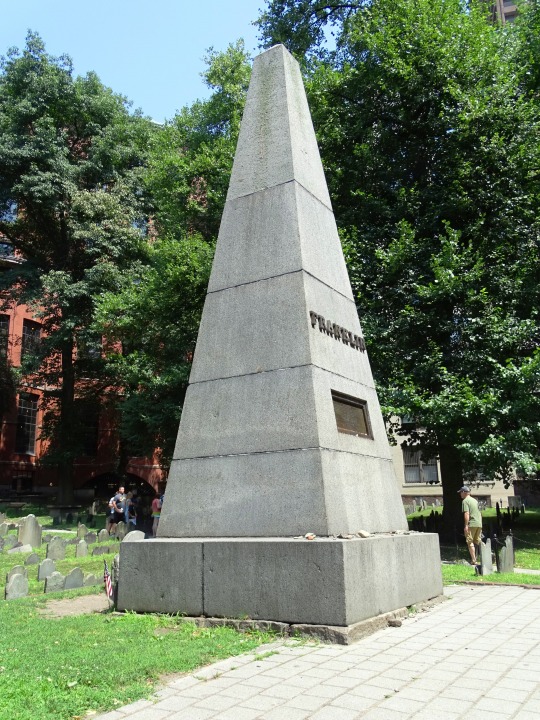


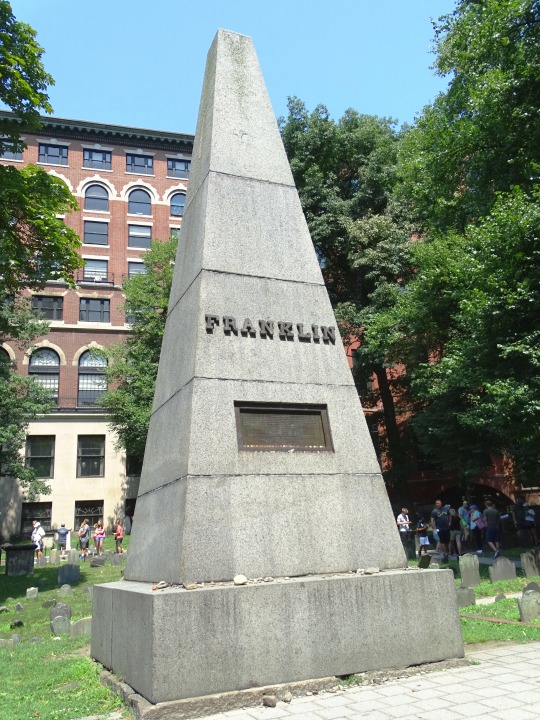

Benjamin Franklin Day
Founding Father Benjamin Franklin was born on this day in 1706, in Boston, making today Ben Franklin Day. He was a polymath, or expert in many subjects. Some of the titles that could be given to him are inventor, scientist, politician, diplomat, civic activist, printer, author, postmaster, and mapmaker. He also founded or was a part of many organizations and groups.
Franklin was the tenth and youngest son of a soap and candle maker, Josiah Franklin, and Josiah's second wife, Abiah Folger. The elder Franklin wanted his son to follow the path of a preacher, but did not have the money to send him to school. Benjamin only attended school up until the age of ten, when he began working full-time in his father's shop. At the age of twelve he was sent to apprentice his older brother James, who was a printer. James started The New England Courant in Boston when Benjamin was fifteen. Benjamin wanted to be printed in the paper, but James would not allow it. So, he wrote letters under name of Silence Dogood, a fictional widow, and slid them under the print shop door at night. The fourteen letters he wrote were published; they gave advice and were filled with critical observations of the world. Benjamin eventually confessed to writing them, and James was not happy. Later, after harassment and beating at the hands of his brother, Benjamin ended up running away to New York, and then ended up in Philadelphia in 1723.
In Philadelphia, Franklin found work as an apprentice printer. He then went to England for several months of print work. He came back to Philadelphia and helped out a printer, but eventually borrowed money and set up his own printing business a few years later. Franklin bought the Pennsylvania Gazette in 1729, which became the most widely read newspaper in the colonies. He printed it and contributed pieces under aliases.
In 1728, Franklin had a son, William; it is not known who the mother was. In 1730, he married Deborah Read; it was a common-law marriage, as Read's first husband had deserted her. The Franklin's had two children: Francis, born in 1732, died at the age of four from smallpox. Sarah was born in 1743.
The Library Company, the nation's first subscription library, was founded by Franklin in 1731. He started publishing Poor Richard's Almanack in 1733, under the pseudonym of "Richard Saunders." Its lively writing and witty aphorisms separated it from other Almanacs of the day, and it was printed for twenty-five years. The first fire department of Philadelphia, the Union Fire Company, was organized by Franklin in 1736. Franklin also worked for environmental cleanup in the city, and launched projects and advocated for paved and lit streets. The first learned society in the country, the American Philosophical Society, was launched with the help of Franklin. In 1751, he brought together another group of people to form the Pennsylvania Hospital.
Franklin's bright mind came up with many inventions. His 1752 kite and key experiment demonstrated that lightning was electricity, and he also invented the lightning rod. He came up with other electricity related terms that we still use today, such as "battery." He invented a fireplace that became known as the "Franklin stove." Compared to the popular fireplaces of its time, it gave off more heat and used less fuel. Franklin refused to patent it, and wanted his invention to serve others freely. Franklin invented bifocals, which could be used for both distance and reading. He even invented a musical instrument, the armonica, which Beethoven and Mozart wrote music for. He charted the Gulf Stream and gave it its name, and suggested the idea for, and helped design the first penny in the United States.
In 1757, Franklin went to England to represent the Penn family over who should represent the colony. Until 1775 most of his time was spent in England. He served as a Colonial representative for Pennsylvania, Georgia, New Jersey, and Massachusetts. His wife Deborah died in 1774, while he was still in London.
Franklin was originally a loyalist, but after the 1765 Stamp Act his views shifted. He testified before Parliament, helping persuade members of that body to repeal the law. He later became embroiled in what became known as the "Hutchinson Affair." Thomas Hutchinson, an English appointed governor, had written letters that had called for the lessening of liberties of colonists. Franklin got ahold of the letters and sent them to America. He was condemned publicly, and soon came back home.
He was elected to the Second Continental Congress, and was part of the committee of five that drafted the Declaration of Independence. He also was a signer of the Declaration. He was the first Postmaster General of the United States; long after his death he was honored by being put on the first US postage stamp.
He left America to become the first Ambassador to France. During this time he helped secure a treaty with them in 1778. He also helped to secure loans during the war. When the guns fell silent, he was present at signing of Treaty of Paris in 1783, which formally ended the war.
Franklin returned to his home country, and became a delegate at the Constitutional Convention; he signed the Constitution, being the oldest person to do so. Although Franklin owned slaves early in his life, his views changed over time, and in his last years he worked for the abolition of slavery. After suffering from gout and other ailments, he died on April 17, 1790, at his daughter Sarah's home. His funeral was attended by 20,000 people.
It is fitting a day would be dedicated to Benjamin Franklin, as he is so much more than just the man on the $100 bill. The breadth and scope of his achievements are almost unparalleled, not only in his political contributions to a fledgling country, but in his many other pursuits as well.
Here are just some of his accomplishments and activities: As writer/printer/publisher:
wrote as Silence Dogood in The New England Courant
published Poor Richard's Almanack for twenty-five years
owned the Pennsylvania Gazette
wrote an acclaimed autobiography
As an inventor:
"Franklin stove"
proved lightning is electricity and invented the lightning rod
bifocals
swim fins
carriage odometer
armonica
flexible catheter
As a founder:
The Library Company—the country's first subscription library
Union Fire Company of Philadelphia—the first fire department of Pennsylvania
American Philosophical Society
Pennsylvania Hospital
As a politician:
Colonial representative in England
member of Second Continental Congress
first Postmaster General of the United States
helped draft the Declaration of Independence and signed it
first ambassador to France
present at signing of Treaty of Paris
delegate to Constitutional Convention and signed Constitution
How to Observe
One way to celebrate the day is to follow the example he left of living a full life. Maybe you can start to do this by following his daily schedule. Learning more about the man may be a good way to celebrate his birthday and life as well. Why not read the man's own words in his Autobiography? You could also read his Silence Dogood letters, or some of Poor Richard's Almanack. Besides reading his own words, you could read books about him, or explore resources at the Library of Congress. Once you tire of reading you could find and watch the PBS mini-series on Franklin. Finally, you could plan a trip to visit his grave and the Benjamin Franklin Museum in Philadelphia.
Source
Benjamin Franklin, an American polymath and one of the Founding Fathers of the United States, was born on January 17, 1706.
#Benjamin Franklin Statue by Richard Saltonstall Greenough#Franklin Monument#summer 2018#Boston#Massachusetts#original photography#travel#USA#vacation#sculpture#public art#old city hall#cityscape#Freedom Trail#architecture#New England#Granary Burying Ground#Benjamin Franklin Day#birthday#17 January 1706#anniversary#US history#tourist attraction#landmark
3 notes
·
View notes
Photo

Sarah Franklin Bache (September 11, 1743 – October 5, 1808), sometimes known as Sally Bache, was the daughter of Benjamin Franklin and Deborah Read. She was a leader in relief work during the American Revolutionary War and frequently served as her father's political hostess, like her mother before her death in 1774. Sarah was also an important leader for women in the pro-independence effort in Philadelphia. She was an active member of the community until her death in 1808.
When Sarah was born in 1743, Benjamin Franklin was thirty-seven and intently focused on furthering his career and wealth. Growing up, Sarah did not have a very close relationship with her father. Franklin's reserved nature towards his daughter may have been partially due to the previous loss of Francis. But Franklin was also deep into his experimentation with electricity by the time Sarah was a young child, and by her early teenage years, he had left for Europe.
Franklin would begin to consider men and women as more intellectually equal later in his life, but he did not take this approach to his own children and grandchildren. It was not unusual for men during this time to take a more aloof approach towards their daughters' education than towards their sons' education. Daughters were typically given the education they would need to be good housewives as that would be their most important job. The education Sarah received was thus typical for women of her status during the 18th century. She was taught reading, writing and arithmetic, as well as spinning, knitting, and embroidery. Franklin also had Sarah enrolled in dance school. When Franklin traveled to Europe in Sarah's early adolescence, he left Deborah Read to take care of the "Education of my dear child." It is also possible that Sarah learned French. Benjamin Franklin once gave Sarah a copy of Samuel Richardson's Pamela; or, Virtue Rewarded in a French translation to "help her with her French. She must have already read it in English."
3 notes
·
View notes
Note
Moooooooo!!!
Moobean, if you will.
How art thy gracious eyeballs?
Do you have any tips on writing fantasy that you’d be willing to share?
Worldbuilding is fun but sooo tedious and detailed. I like making myself suffer tho, so we’ll see how it turns out. Hmm…I need to think up conflicts too…lots to do…
Good thing first chapter in fics don’t have deadlines…ahaha…
But also HOW???
Do I start a story, like hello?
I feel like every time I begin writing a new idea, my writing brain just takes vacation without giving it’s two weeks lmao.
And then I’m just left with all the angry clients which are no one but myself and my reflection in the mirror across my room, whom I talk to sometimes….
Don’t let me take up your time tho, I’m just venting. I think.
Well, ta-ta!
Oof good question babe. like, fantasy is SO MUCH. though i think it's much easier than sci-fi so... there's that.
the good thing about fantasy is that you get to make it up. it doesn't need to make any sort of realistic sense the way sci-fi kinda does.
idk if you've ever watched It's Always Sunny in Philadelphia but there's this episode where the gang "turns black" and they do like a musical like the Wiz and what not and there's this song they sing throughout the episode called "What are the rules?" and every time i'm thinking up stuff about a story that isn't based in reality, i sing that song in my head lmao
because that's the most important question when you're dealing with fantasy or some other unrealistic setting.
What are the rules?
Is there magic? Who can use magic? Is it learned? or something you're born with? what sort of magic is there? restoration magic like healing and destructive magic like shooting fireballs from your hands? or something different? Are you using fantasy races like elves and dwarves and stuff? or even original races you're making up yourself the way Skyrim does with the Khajiit and Argonians? are any of those races more inclined to be magical? What about magical beasts like griffins and dragons and trolls? do they exist and if they do, what are they like? can they speak? are they threats to your main characters? or are they more of reclusive animals? what about alchemy and enchantments? does that stuff exist? is it separate from magic or intertwined with it? do the people in your fantasy world have different qualities than people in reality? like do they live longer? need different food? can they do things that real people can't do that aren't magical in nature? like jump really high or hold their breath for hours or shoot arrows while doing backflips? what of the animals? are they like our animals or are there new ones? or do they just act differently than their realistic version? what jobs do they have in this fantasy world that they don't have in our reality? are there messenger bunnies and soldier tigers or massage therapist octopuses? and technology? is there electricity or other sciencey things? Or is everything controlled by magic? or maybe it's old school where it's all torches and lanterns and other pre-electricity things?
what are the rules?
take your time thinking these things up. Watch or read other fantasy media to help give you some ideas about more stuff you can include in your setting to make it feel fleshed out. You don't have to put it ALL in your story, but you know how inspiration works. It's sometimes totally random. You can be halfway through the story and suddenly decide "Yes, i AM going to include this thing" and guess what? good for you because you already had it in your head and unconsciously prepared yourself for this moment. You've hopefully left room in the story to accommodate such a thing already so you won't have to backtrack and edit yourself to change rules.
write this shit DOWN. don't trust yourself to remember it all. I don't care how good you think your memory is, write it down. It's hard to keep track of every little thing you think of. so take notes. they don't have to be perfectly organized (though that will help a LOT if you're able to do it)
How do your characters speak? this is something that I struggle with when it comes to writing fantasy. the language in fantasy is always so... old timey and flowery, you know? and i hate writing like that. i start writing in that way, having the characters speaking like olden times but then i get irritated with it and abandon it. that's okay. who said fantasy needs to be all proper and stuffy anyway? Modern fantasy is a thing. also it's FANTASY. aka its not real. then again, there's nothing wrong with sticking to that old style of speaking if that's the vibes you're going for
choose how you want your characters to speak, and stick to it. Be conscious of your word usage and phrases. if you're going for the old style of speaking, be aware that there are a ton of phrases that would not fit with that style. We use so many references in our speech that would make literally zero sense in an olden days setting. This isn't SUPER important because like... who is picking apart your story like that? they can chew rocks if they're that snobby that they're gonna be bothered about a stray baseball idiom thrown into a story set in a world where baseball doesn't exist.
BUT, if youre someone who likes to be accurate, just keep an eye out for those types of things 😉
also, figure out your physical setting. WHERE is this story taking place? what sort of physical features are there? and what connections do those physical features have?
you know how in Lord of the Rings, there's like... the shire, which is all these sweet rolling hills and prairies and fields of wheat and cute little woods where hobbits just eat and drink and party all day long and it's so peaceful and cute? then there's Mordor and it's like volcanic desolation and nasty little creatures beating the fuck out of each other on the rocks? then there's Moria and all these mountains and dwarves live inside them with this spectacular architecture like wow amazing ingenuity and technological advancements and mining and smithing? then of course the elves live in Rivendell the big beautiful forest with all these beautiful waterfalls and tall golden trees and it's whimsical and magical and sexy just like them? then all the places where men live are like just out there in these fortresses and cities that feel very manlike?
The environments are detailed and varied and they suit the races that claim them as their homes. it's like DUH the elves live in a gorgeous place like that and DUH the place where all the nasty bad guys live looks like THAT. DUH the hobbits, carefree little guys, live in a place that looks so friggin peaceful and cute. Think about where your characters live and why they live there. Draw a map if you want to! Or hey, pick a country that already exists and use it as the base of your map. Who cares? some countries just have a good shape, you know? I'm partial to Chile like... why you such a long boyo?
what about the politics and social aspect of your world? are the races separate and rule over themselves? or is there like a king or emperor that is in charge of the entire place? maybe it's just a free for all? how do the different races feel about each other? do the elves hate the dwarves and the humans hate the mermaids? are there alliances? interracial mingling? discrimination? are there any wars currently waging? civil or foreign? what about gender politics? are women equal to men? what about people who don't fit into the gender binary?
and what of religion? are there gods? do the different races believe in different gods and religions? do those gods actually exist and interfere with the mortals? or are they more conceptual? is there bad blood between gods and religions?
what about the supernatural stuff? vampires? zombies? ghosts and ghouls and spirits? an afterlife? many afterlives for the different races and creatures?
there are so many questions you can ask yourself! and maybe you don't need to answer them all. maybe your story isn't supposed to be THAT epic. maybe it's smaller scale. that's okay. pick the ones that you find vital and really figure them out. write down ALL of your ideas, even if some of them will get discarded later.
don't worry too much about how to start the story. just start. you can always go back and rewrite the beginning. the most important thing is to get words coming out. even if that means you just start with something like "Jeffrey hates Mondays and here's why:" like go on, just begin and let yourself work through some nonsense just for the sake of making your fingers do the type type type. then later, when you've gotten stuff kinda flowing and feeling good, you can revisit that early stuff and edit it to be an actual introduction to your story. beginnings are HARD. probably the hardest part of writing a story. though they probably share first place with endings because those are hard too.
Don't sweat it! so long as you're writing, you're doing a GREAT job. fantastic, really. better than most writers. because sometimes we struggle to even get past the brainstorm stage. which is totally valid and also an important experience for writers. Struggle makes success taste so so delicious.
whatever happens, i'm sure you'll do awesome and will be super happy and proud. as you should be! writing is so difficult but so fulfilling and i wish you and every writer out there the energy and motivation to spit out 300k words like it's nothin
good luck! hope i helped, even if it was just a lot of asking you questions you should ask yourself heh. i just woke up so my brain is working at like quarter capacity so, ya know.
anyway, i believe in you! 🌈🖤 have fun!!!!!!!
1 note
·
View note
Text
Electrician certification is a great way to explore the industrial electrical system. Discover more about the industry with electrician apprenticeship.
#electrician trade schools#automation technician in philadelphia#electrician certification training Institute in Allegheny West#electronics school in philadelphia#electrician certification pa#electrical certification courses in philadelphia#electrical courses in philadelphia#electric certification in philadelphia#electrician trade Programs in North east Philadelphia#electrical learning in philadelphia#electrician trade Programs in Wynnfield Heights#electrician certification training Institute in north philadelphia east
0 notes
Text
One of my life goals is to be a polymath. I want to know as much as I can and learn how to put it into use. I think Robert Heinlein, as cringe as he was, was correct about one thing.
"A human being should be able to change a diaper, plan an invasion, butcher a hog, conn a ship, design a building, write a sonnet, balance accounts, build a wall, set a bone, comfort the dying, take orders, give orders, cooperate, act alone, solve equations, analyse a new problem, pitch manure, program a computer, cook a tasty meal, fight efficiently, die gallantly. Specialization is for insects."
Speaking of polymaths, here's a list of people I have respect for for being polymaths.
1. Leonardo Da Vinci: Artist, sculptor, architect, inventor, engineer, scientist, theorist, the true Renaissance man. Painted things like the Mona Lisa, The Last Supper, Lady With An Ermine and Salvator Mundi. Came up with early drafts for the helicopter, airplane, submarine, tank, and various other things. Wrote notebooks and drew sketches of several different subjects, including anatomy, astronomy, botany, cartography, painting, and paleontology.
2. Ben Franklin: You know him, you've seen him on the $100 bill, you probably love him, he's great at a lot of things. The first ever postmaster general of the US, the first ambassador to Sweden and France, invented swimming paddles at just 11 years old, later invented the glass harmonica and Franklin stove, helped print some of the first ever newspapers in America, the New England Courant and later the Philadelphia Gazette, founded the University of Pennsylvania, the first fire department, police force (unfortunately), and hospital, did the famous kite experiment that proved lightning was a form of electricity, drafted and signed the Declaration of Independence and Constitution, came up with many aphorisms thanks to Poor Richard's Almanack (which was like any other almanac plus the aphorisms), the Silence Dogood letters, and many other writings, charted and named the Gulf Stream, laid the groundwork for modern demography, and was probably the first ever shitposter. I could name more stuff but honestly this is enough for me and maybe everyone else.
3. Rabindranath Tagore: The Da Vinci of Asia, arguably. A poet and composer who came up with the words for the Indian and Bangladeshi national anthems; an author who made several famous books including Gitanjali, a Nobel Prize-winning poetry anthology (HE WAS THE FIRST POC TO WIN A NOBEL PRIZE), Gora, and The Home and The World, among other literary works that have been adapted into films time and time again by Indian cinema studios; a playwright whose plays have also been adapted to the big screen frequently; a painter inspired by, among other things, Papua New Guinean masks from the Malagan people, Haida carvings from the Pacific Northwest, and the woodcuts of German artist Max Pechstein; a staunch advocate for Indian independence until his dying days, and a child prodigy, writing poetry as early as 8, and publishing his first poetry collection at 16. More people should be talking about this guy.
And finally 4. W. E. B. Dubois: Black sociologist, historian, author, and civil rights activist. He co-founded the NAACP in 1909, wrote his most famous work, The Souls of Black Folk in 1903, a seminal work of POC literature, was the first Black person to earn a doctorate in history, especially from Harvard (!!!!), and a very active member of the civil rights movement as early as the turn of the century. He is also the person that has lived the longest out of all the people on this list, as he died in 1963, at the ripe old age of 95, one year before the Civil Rights Act passed.
Let me know what you think.
#history#polymath#web dubois#rabindranath tagore#ben franklin#leonardo da vinci#seriously these people are probably the best
4 notes
·
View notes
Text
Advantages of a Stannah Stairlift in South Jersey and Philadelphia
Being plagued with mobility issues can rob an individual of happiness. Indeed, going out to meet friends and family becomes difficult, and social events are not easy to attend either. Unfortunately, even the home of many years can be restricted with the homeowner unable to climb the stairs to reach the upper floors, basement, or attic. Not everything is lost, however. One can always go with installing a quality Stannah stairlift in South Jersey and Philadelphia and ensure full accessibility without any compromises.
It helps to know that a stairlift is an ideal alternative to traditional stairs and comes as a Godsend for seniors and persons battling disabilities. It is a mechanical device powered by electricity and can have the seated user ascend to the right level without having to struggle physically. There is no need for additional construction or breaking down the existing walls to incorporate the stair lift, either. On the contrary, it can be installed beside the existing stairway and will follow the path perfectly.
Another pleasing factor to remember is that such devices have no learning curve! Instead, the user can operate it singlehandedly and remain in complete control. The comfortable seat, arm, and footrests provide comfort and convenience, making the device a perfect mobility solution for the consumer.
Admittedly, there are many brands of stair lifts available in the market. The top brands focus on comfort, convenience, and the quality of operation, which is usually noiseless. The brand name Stannah stands out from the competitors and is the first choice of many customers today.
There are various types of stair lifts manufactured and sold by Stannah. Still, the following varieties are always in high demand, making every dealer across the nation stock the following types of stair lifts:
· Straight - This is the most common type of stair lift with no twists and turns in the design. As the term implies, the stair lift is straight and may be fitted alongside a straight stairway with no bends or landing in between.
· Curved- This type of stair lift is perfect for installation besides an intricate stairway with several twists and bends. Often, an expansive landing in between floors may be surmounted by installing a customized stair lift designed to mimic the existing stairway.
· Outdoor- Apart from ascending the desired level within the home, the property owner may wish to sit on the patio, reach the garden, or stroll in the backyard with a cane or walker. Installing a stair lift that is manufactured for outdoor accessibility can help such individuals enjoy the sunshine and natural breeze.
It is essential to note the pluses of a Stannah stairlift in South Jersey and Philadelphia before spending money on it. These branded stairlifts are highly popular for their enticing designs, styles, and perfect comfort. With two years of warranty on a new product, the end-user is assured of value for money.
0 notes
Text
Repairing Your Old HVAC vs. Buying a New One: Which Is Cheaper?
Deciding whether to repair your old HVAC system or invest in a new one can be challenging. While HVAC repair and AC repair can often be more cost-effective in the short term, it may not always be the best solution. If your system requires frequent repairs and is inefficient, upgrading to a high efficiency HVAC system could offer long-term savings on energy bills. For homeowners in Havertown, an experienced HVAC company in Philadelphia can provide an HVAC tune up service to assess your current system's condition and help you make an informed decision.
Learn More: https://boylebrothersenergy.com/blog/tips-to-reduce-ac-electric-bills-this-summer/
0 notes
Text
Transit Talk Thursday

Transit Talk Thursday: Okie dokie, this was not a thread I was intending on making, but unfortunately my hand was forced. Half as Interesting has always been to me the pinnacle of content mill garbage, but this has got to be the absolute pinnacle of content mill garbage with how it basically gets every single important detail wrong in some capacity. It's so bad that I couldn’t just stand here and watch from the audience. I had to get involved in some way, and this is the best way that I could think of. Let’s dissect this absolute travesty of a video together, and maybe we’ll learn a few things along the way.


First of all, the map he shows of the Northeast Corridor (first image) is inaccurate*. It highlights the Keystone Corridor, a portion of the Empire Corridor, and the Springfield Corridor. This I take a bit of issue of because most foamers agree that the Keystone Corridor from Philadelphia to Harrisburg and Pittsburgh, the small snub of the Empire Corridor and the Springfield Corridor are considered separate corridors, but the Northeast Corridor Commission does consider those to be a part of the NEC, so this is fine, if not a tiny bit annoying. Though based on how it looks, it's likely Ben Doyle (the writer of the video) just took the map of the NEC and its adjacent corridors off of Wikipedia (second image) and used it in the video. This one is based off of a technicality so I can give Ben the benefit of the doubt this time. I wish I could do the same for the next ones though!

So the next thing I take issue with is the point about electrification systems. Sam says that the ex-PRR system running on 25Hz is apparently a problem because since it runs on a different frequency, it's impossible to upgrade without tearing it all down. So to explain this one, the Northeast Corridor has three separate electrification systems powering it. The first is the Southend Electrification (see above), running on 11kV 25Hz AC electrical power, built by the Pennsylvania Railroad, and the one which has the problems. The next is the 12.5kV 60Hz AC system, which is a remnant of the New York, New Haven, and Hartford Railroad. This one powers the NEC from New York Penn Station to New Haven Union Station. The last is the Northend Electrification, running on 25kV 60Hz AC power, which was done by Amtrak in the 1990s. The Pennsylvania Railroad built their system on 25Hz because it was a fairly prevalent system for industrial use, and this was before 60Hz became the standard for North America. With that being said, Sam's point about it being impossible to upgrade due to it requiring special equipment and infrastructure is just wrong. Amtrak has upgraded this system before (you'll see an example later), so the notion of it being a problem because its 25Hz while the other systems are 60Hz, and as a result, using special equipment is just wrong. Second of all, even if we’re coming from the perspective of “Oh but what about the trains you run on the system, that’s gotta be the real problem”, that’s…not a problem at all. Rolling stock that can work for all three electrical systems of the NEC are available and we still roster them even today, like Amtrak’s current ACS-64s. Ben even wrote that its impossible to tear it all down and start from scratch, so that's what Amtrak has decided not to do. Amtrak instead just works around it, and whaddya know, it works just fine.

Next thing is the detail Amtrak apparently absorbed PRR in 1975. This statement is what made me do this thread. It is the pinnacle of how Ben doesn’t know what the hell he’s talking about when it comes to trains.
For the uninitiated, the Pennsylvania Railroad was not absorbed into Amtrak in 1975, because it didn’t even exist in 1975! What Ben got wrong here was Amtrak absorbed the passenger operations of Penn Central, the successor of the Pennsylvania Railroad, created from a merger of PRR, the New York Central, and the New Haven Railroad, while Conrail took over the freight side. The reason why Amtrak and Conrail even came to existence is because the Penn Central merger was so horrible it created one of the largest bankruptcies in United States history, and it forced the Nixon Administration to create Conrail and Amtrak to plug the gaping hole in the United States’ transportation network. Every single foamer worth their weight knows this story, to get this wrong in a video meant to "inform" (hard air quotes) people is an indication of extreme carelessness.
So the explanation of constant-tension catenary is “fine”, apart from how Sam didn’t say what it actually was by its correct name, but what I take issue with here is the lack of an explanation as to why the ex-PRR catenary is so bad, and why these issues haven’t been seen on other segments of the NEC.
So Alan Fisher has a great thread explaining why on his Twitter, but because not everyone has Twitter (good for you), I’ll explain it here as well.


The reason why Amtrak and New Jersey Transit were experiencing outages due to downed wires is because a majority of the ex-PRR wires are simply fixed into place on the catenary poles (see above). This is an issue because when the wire heats up, it sags, which makes it so a train’s pantograph can strike it and bring the wire down. By comparison, the section between New Haven, CT and Boston, MA done in the 90s (Known as the Northend Electrification, see below) has constant-tension catenary, which means the wire is kept tight with calibrated weights. This is good because it means no matter how much the wire expands, the weights can pull the wire tight. Unfortunately, a majority of the ex-PRR system lacks constant-tension, so whenever the temperature heats up (like it did in July), the wires will sag, and the chance for the system to be downed due to a wire being taken down is elevated.

Now the final thing I want to go over is Sam saying that Amtrak did get money to upgrade a section of the NEC between Trenton and New Brunswick, NJ, but they only did 7 miles of the section before “calling it a day”. First of all, the notion that Amtrak only did 7 miles of the Trenton - New Brunswick section is very wrong. Amtrak has an OIG report which details that the entire section has constant-tension now, which is why the Acela is able to hit a top speed of 150mph there. Second of all, Sam fails to mention the actual reason why they only did 7 miles at first. The actual reason why is because due to a clusterfuck regarding mismanagement of federal funds, there was only enough money to do 7 miles of the entire corridor. There’s an OIG report which mentions it here. Saying that they did just 7 miles and “called it a day” with no elaboration is indicative of, once again, extreme carelessness and laziness. But then again, I probably shouldn’t expect anything more from a content mill.
BONUS: If you're wondering why Amtrak did this 20 mile stretch first, its due to Amtrak anticipating their new Acela trainsets, coming sometime in Q4 of this year. [Source]
So, conclusion?
This video was insanely painful to watch for me. I have always disliked HAI for its writing style, but now the channel has decided to just publish blatant lies for their mindless subscribers to gobble up like vultures. This kind of stuff will keep happening so long as so many people are misinformed and uneducated about trains. But it doesn't have to be this way. This is why I'm making this post. Not because I want to cash in on some "Internet clout" or something stupid like that. Rather, I'm doing this to spread the truth, to counter this 8 minute package of lies put out by a channel which has much higher production values than what I could muster. I may not be able to edit well, voice scripts that well, make eye-catching motion graphics, or make interesting graphics. But what I am able to do is talk about trains and transit in an informative, educational, and most importantly, accurate way. And at the end of the day, that's all that I care about.
1 note
·
View note
Text
A Shocking Turn to Enlightenment: Benjamin Franklin and the Machines That Learn
My dear friends, gather 'round as I recount an electrifying tale—one that begins not in the cobblestone streets of Philadelphia, but in the tempestuous clouds above, where a certain kite once danced with lightning. Yes, I speak of that infamous experiment, where a key, a string, and a bolt from the blue conspired to unveil the secrets of electricity. Little did I know, that same fiery curiosity would one day lead me to the beguiling world of machine learning. Sit tight, for this narrative is as winding as the Mississippi and as unexpected as a barnyard pig with a penchant for opera.
It all started on an otherwise uneventful Tuesday afternoon. I had just completed my latest invention—a rather ingenious contraption for roasting turkey using electric current, a culinary breakthrough I was certain would revolutionize Thanksgiving. However, as fate would have it, the device had other plans. A miscalculation on my part (blame it on the sherry, if you must) resulted in an explosive incident that left the turkey charred beyond recognition and my wig singed in a manner most unbecoming.
Seeking solace and inspiration, I decided to take a stroll through the bustling streets of Philadelphia. As I meandered past the apothecary, the butcher, and the tavern (where, admittedly, I paused for a refreshing libation), I stumbled upon a gathering outside the printing shop. Curious, I joined the crowd and discovered a gentleman of peculiar attire, clutching a box from which emanated strange noises and flickering lights.
"Ladies and gentlemen," he announced, "behold the Automaton! A marvel of modern ingenuity, capable of playing chess with the skill of a grandmaster!"
Intrigued, I watched as this mechanical wonder, with its gears whirring and pieces clicking, deftly outmaneuvered its human opponent. My mind, ever the restless spirit, began to whir faster than the contraption before me. If a machine could learn to play chess, what else might it be capable of?
That night, as I lay in bed, visions of mechanical marvels danced in my head—though, in fairness, it could have been the aftereffects of the tavern's particularly strong ale. Nevertheless, inspiration struck! What if I could harness the principles of learning and apply them to these mechanical contraptions? Could we create machines that learn from experience, much like we humans do?
The following morning, with renewed vigor and a wig still slightly askew, I set about my task. My first attempt involved attaching a series of gears and pulleys to a set of bellows, hoping to create a device that could learn to play a tune. The result was less a symphony and more a cacophony, reminiscent of a cat in distress. Undeterred, I pressed on, refining my designs and studying the principles of learning.
One evening, as I pondered the complexities of cognition over a glass of Madeira, it struck me—algorithms! Just as my recipes for brewing beer involve precise steps and ingredients, so too could a machine follow a set of instructions to learn and make decisions. I delved into the works of learned scholars and mathematicians, piecing together the concepts that would form the foundation of what we now call machine learning.
But why, you might ask, did I, Benjamin Franklin, polymath and kite-flyer extraordinaire, embark on this peculiar path? The answer, my friends, lies in my unquenchable thirst for knowledge and my belief in the boundless potential of human ingenuity. If we could capture lightning in a bottle, why not harness the power of learning itself?
Thus, I present to you my latest endeavor, a discourse on the ingenious mechanisms of machine learning. May it illuminate your minds as surely as my kite once lit up the stormy sky. And remember, whether taming electricity or teaching machines to learn, the pursuit of knowledge is a journey fraught with unexpected twists, delightful discoveries, and the occasional singed wig.
Onward, dear readers, to the fascinating world of learning machines!
0 notes